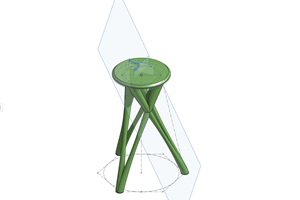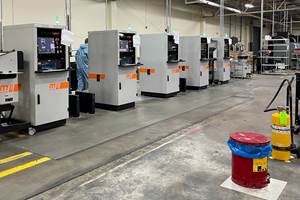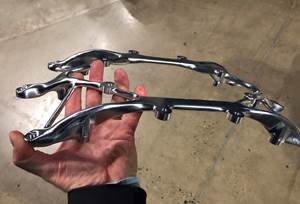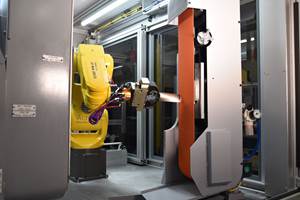Updated nTop Platform Advances AM Design, Simulations
The updated design and simulation solution builds upon nTop's core technologies and introduces new capabilities across four key themes — design, integration, scaling and adoption.
The company’s nTop 4 offers a holistic approach to design for additive manufacturing (DfAM), enabling engineers to deliver highly engineered AM parts for products to reach new levels of performance. Photo Credit: nTop
Engineering design software company nTop (formerly nTopology) has updated its flagship design and simulation solution to offer nTop 4. With a holistic approach to design for additive manufacturing (DfAM), nTop 4 is said to enable engineers to bring additive manufacturing (AM) to mainstream production. This release builds upon nTop’s core technologies and introduces new capabilities across four key themes — design, integration, scaling and adoption.
“At nTop, we have always believed that design is at the core of solving the world’s hardest engineering problems,” says Bradley Rothenberg, nTop co-founder and CEO. “nTop 4 marks the next stage of our journey, enabling engineers to deliver highly engineered AM parts for products to reach new levels of performance.”
The nTop 4’s Field Optimization is a generative design technology that helps engineers navigate the overwhelming number of design parameters introduced by complex engineering problems, accelerating decision-making and improving part performance. This feature layers a multiscale and multi-objective optimization engine on top of nTop’s core technology, resulting in a design tool that is both powerful and easy to implement, the company says.
The Field Optimization feature also introduces easy-to-use workflows enabling engineers to generate better-performing AM part designs for applications such as lightweighting, medical implants and industrial design. The company says it will continue developing capabilities of this new technology in future releases.
The integration element is said to eliminate data exchange bottlenecks with Implicit Interop. The Implicit Interop function is said to eliminate data exchange bottlenecks for even the most complex designs, enabling data transfer between nTop, manufacturing, CAD and CAE software in files sizing in the megabytes, not gigabytes.
The nTop 4 also includes nTop Core which is a developer library that makes it easy for partners to implement native Implicit Interop integrations and is already in use by nTop’s partner ecosystem. The nTop plugin for EOSPrint is the first Implicit Interop software connection which will be available with the upcoming release of EOSPrint 2.14 in June. The nTop Implicit File (.implicit) is an nTop file format used to directly exchange implicit geometry without meshing, resulting in smaller file sizes at lossless precision.
The nTop Automate enables users to multiply the impact of engineering resources by executing nTop workflows through a programmatic environment. In addition to the Windows deployment, nTop 4’s nTop Automate for Linux enables engineers to unlock more economical cloud computing or use available on-premise high-performance computing (HPC) resources.
The company is also looking to create value faster with its customer success programs to accelerate adoption and maximize impact in organizations of any size. The nTop Accelerate offers a range of one-to-one training services, custom workshops and design sprints to help nTop’s customers best meet their program objectives. The company also continues to invest in onboarding programs — such as nTop Learn, nTop’s online learning center — to ensure that engineers can deliver value as fast as possible.
- Learn more about nTop’s platform which offers a design and simulation solution for design, simulation and advanced manufacturing processes.
- Read about nTop’s 3.0 version of its AM Engineering Design solution that offers an opt-in feature enabling nTop users to experience an instant 10 to to 100 times performance boost when visualizing workflows that use complex field-driven geometry.
- Check out this article about Stratasys and nTopology’s fixture software that simplifies AM modeling and design. The FDM Assembly Fixture Generator automates design of jigs and fixtures, enabling engineers to quickly turn a part file into a ready-to-print fixture with a simple drag-and-drop function.
Related Content
To Scale Additive Manufacturing, Separate Design and Production
Spokbee’s online marketplace is designed to ease the launch and sale of customizable, 3D printed products. Its flexibility comes from cloud-based CAD and a distributed network of service bureaus for production.
Read MoreAdditive Manufacturing Production at Scale Reveals the Technology's Next Challenges: AM Radio #28
Seemingly small issues in 3D printing are becoming larger problems that need solutions as manufacturers advance into ongoing production and higher quantities with AM. Stephanie Hendrixson and Peter Zelinski discuss 6 of these challenges on AM Radio.
Read MoreLightweight Components: A Paradox When Machining
Today’s computer software can just as easily generate lightweight shapes for subtractive processes as it can for additive ones, but it increases cost and waste to make them.
Read MoreAircraft Engine MRO: How Additive Manufacturing Plus Robotic Finishing Will Expand Capacity for Blade Repair
AM offers the chance to bring fast, automated processing to individualized, part-by-part restoration of turbomachinery. A cell developed by Acme Manufacturing and Optomec is able to automatically repair 85,000 unique aircraft engine blades per year.
Read MoreRead Next
To Improve Performance of Compression Molded Composites, Add 3D Printed Preforms
9T Labs' Additive Fusion Technology enables the manufacture of composite structures with as much or as little reinforcement as is necessary, using 3D printed continuous fiber preforms to add strength just where needed.
Read MoreLooking to Secure the Supply Chain for Castings? Don't Overlook 3D Printed Sand Cores and Molds
Concerns about casting lead times and costs have many OEMs looking to 3D print parts directly in metal. But don’t overlook the advantages of 3D printed sand cores and molds applied for conventional metal casting, says Humtown leader.
Read MoreGE Additive Rebrands as Colibrium Additive
As part of the brand name transition, both the Concept Laser and Arcam EBM legacy brands will be retired.
Read More




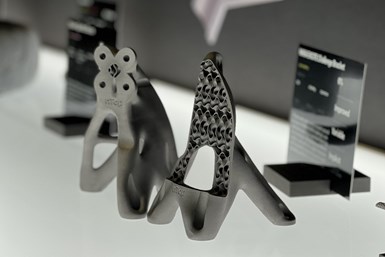








.png;maxWidth=300;quality=90)



